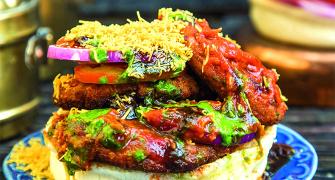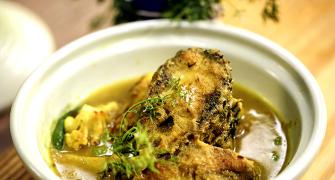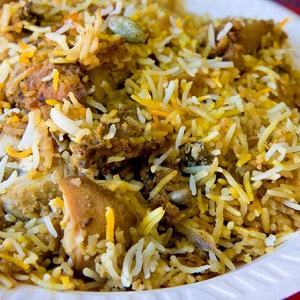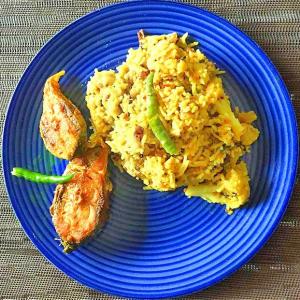The book The Mughal Feast features authentic recipes and cooking tips from emperor Shah Jahan's era.
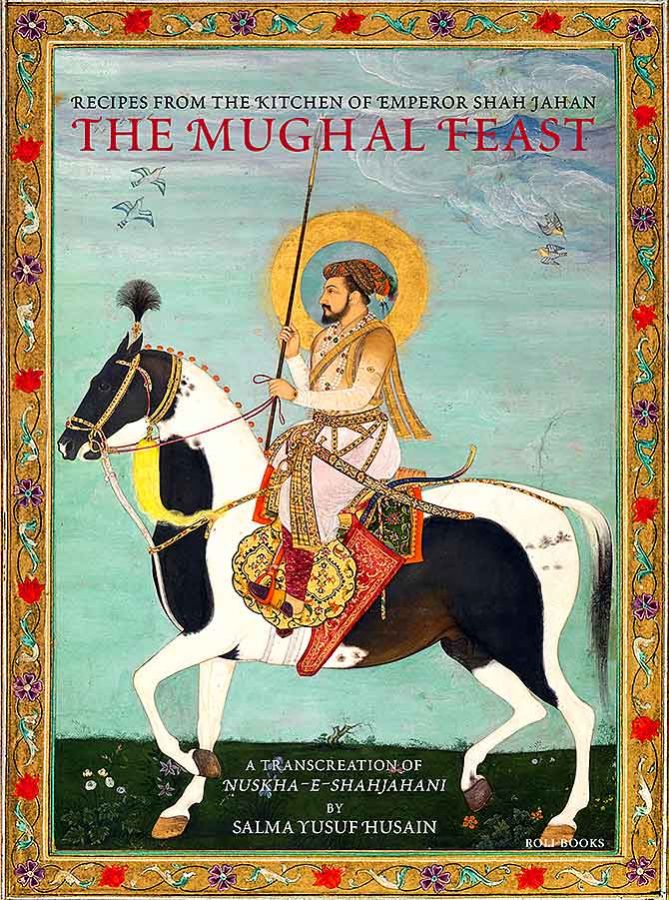
Does your mouth water at the thought of biryani and kebabs?
In the book The Mughal Feast: Recipes From The Kitchen Of Emperor Shah Jahan, Salma Husain has put together some traditional recipes from the royal kitchens during Mughal emperor Shah Jahan’s time.
Husain has carefully divided the recipes into seven sections -- naan (bread), aash (soup), Aliya and do-piyazah (gravy), bharta (minced), zeer biryani and pulao, kabab and shiriniha (sweet).
There are special cooking instructions and tips on how to clean meat, soften bones, enhance cooking and retain flavours.
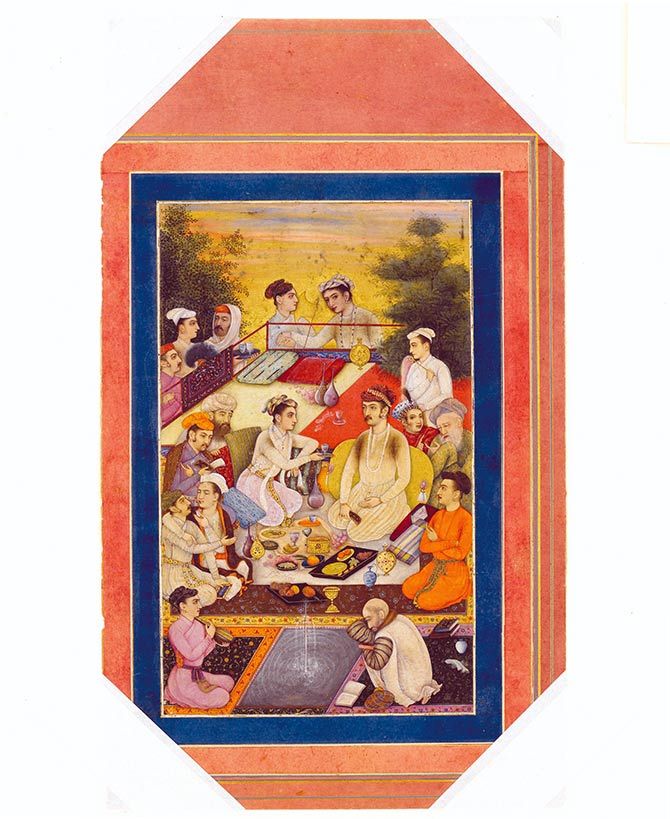
Presenting some exclusive recipes featured in The Mughal Feast.
Aash-e-Nakhudi
Serves: 8-10
Thick sweetened lamb and vegetable soup
Ingredients
- Lamb, cut into medium-sized pieces 2 kg
- Ghee 2 cups / 500 gm
- Onions, sliced 2 cups / 500 gm
- Salt to taste
- Ginger (adrak), chopped 8 tsp / 40 gm
- Beetroots (chuqander), cut into cubes 1 cup / 250 gm
- Carrots (gajar), cut into cubes 100 gm
- Turnips (shalgam), cut into cubes 1 cup / 250 gm
- Cloves (laung) ½ tsp / 3 gm
- Egg white 1
- Sugar 3 cups / 750 gm
- Juice of lemons (nimbu) 3
- Coriander (dhaniya) seeds, pounded 8 tsp / 40 gm
- Almonds (badam), fried, ground to paste 5 tsp / 20 gm
- Rice paste 8 tsp / 40 gm
- Cinnamon (dalchini), ground ½ tsp / 3 gm
- Green cardamoms (chotielaichi), ground ½ tsp / 3 gm
- Black peppercorns (sabut kali mirch), ground 2 tsp / 10 gm
- Spinach (palak) ½ cup / 125 gm
- Dill (soya saag) ½ bunch
- Saffron (kesar) ½ tsp / 3 gm
Method
1. Heat the ghee in a pan; add the onions and fry until golden. Add half the lamb pieces, salt and chopped ginger; fry until the lamb changes colour. Add sufficient water to partly cook the lamb.
2. Now add the beetroots, carrots and turnips with 3 cups water to cook the meat and vegetables on low heat.
3. When the lamb and vegetables are cooked and at least 1½ cups water remain in the pan, separate the lamb and vegetables from the stock and reserve. Strain the stock and temper it with 2 cloves; keep aside.
4. Make a fine mince of the remaining lamb pieces. Make a dry do-piyazah* (check notes below) with the mince and grind to a fine paste. Add white of egg and knead into a dough. Make marble-sized balls of this mix and deep-fry in hot oil.
5. Make a sugar syrup of one-string consistency with lemon juice*. Add half of the syrup to the reserved stock and bring to a boil.
6. Add the pounded coriander seeds, almond paste and rice paste to the stock; mix well.
7. Sprinkle ground cinnamon, remaining cloves, cardamom and black pepper; mix well. Add the spinach, dill and lamb pieces; bring to a soft boil and remove from heat.
8. Transfer into a serving bowl. Add the remaining syrup to the prepared soup and serve hot garnished with saffron.
Zeer Biryan Paneer
Serves: 6-8
Rice with cottage cheese and green gram
Ingredients
- Rice 4 cups / 1 kg
- Cottage cheese (paneer), cut into ¾" cubes 1 cup / 250 gm
- Wholewheat flour (atta) 8 tsp / 40 gm
- Salt 8 tsp / 40 gm
- Yoghurt (dahi), hung, whisked ½ cup / 125 gm
- Saffron (kesar), dissolved in water 1.5 gm
- Green cardamoms (choti elaichi), crushed ½ tsp / 3 gm
- Onions, slices ½ cup / 125 gm
- Ginger (adrak), chopped 4 tsp / 20 gm
- Cinnamon (dalchini) ½ tsp / 3 gm
- Cloves (laung) ½ tsp / 3 gm
- Black peppercorns (sabut kali mirch) ground 1.5 gm
- Ghee 1½ cups / 375 gm
- Green gram (cholia), fresh, washed ½ cup / 125 gm
- Flat bamboo sticks as needed
Method
1. Mix the wheat flour and salt with water in a bowl and make a thick batter. Cover the cottage cheese pieces with this batter and deep-fry until golden brown. Keep aside.
2. Mix the whisked yoghurt with the saffron and half of the finely crushed cardamom seeds; apply this mixture over the fried cottage cheese pieces.
3. Take a wide, thick-bottomed pan; arrange flat bamboo sticks in a criss-cross way in the bottom of the pan.
4. Remove the cottage cheese pieces from the yoghurt mixture and place them over the bamboo sticks. Place the onion slices along with ginger, cinnamon, cloves, ground pepper, and ¾ cup ghee over the cottage cheese pieces.
5. Parboil the rice and spread it over the cottage cheese pieces. If the rice is a little hard, sprinkle 2 tbsp water to make it soft. Colour some rice with saffron and put on one side of the pan.
6. Spread the green gram over the rice.
7. Heat ¾ cup ghee to smoking point and pour around and on top of the rice. Place 1 cup wheat flour on top of the rice, cover and seal the pan.
8. Place live charcoal on the cover of the pan and put on dum* for 5 minutes.
Amba Pulao
Serves: 6-8
Sweet and tangy mango lamb rice
Ingredients
- Lamb, cut into pieces 1 kg
- Rice 4 cups / 1 kg
- Ghee 1 cup / 250 gm
- Onions, sliced 1 cup / 250 gm
- Ginger (adrak), chopped 4 tsp / 20 gm
- Coriander (dhaniya) seeds, crushed 4 tsp / 20 gm
- Salt 4 tsp / 20 gm
- Cloves (laung) 1 tsp / 5 gm
- Raw mangoes (kairi) 1 kg
- Sugar 3 cups / 750 gm
- Cumin (jeera) seeds 2 gm
- Black peppercorns (sabut kali mirch) 1 tsp / 5 gm
- Cinnamon (dalchini), 2 sticks 1" each
- Pistachios (pista), fried ½ cup / 125 gm
- Almonds (badam), fried ½ cup / 125 gm
- Raisins (kishmish), fried ½ cup / 125 gm
Method
1. Make yakhni with the lamb pieces*, ghee, onions, ginger, crushed coriander seeds and salt. Strain the stock and separate the lamb pieces.
2. Add half the mangoes to the stock, and cook until tender. Remove from heat and keep aside to cool. Squeeze the mangoes with hands to extract thick pulp. Strain and keep the mango stock aside.
3. Make a sugar syrup of one-string consistency*.
4. Cut the remaining mangoes into pieces, boil in water and then float in this sugar syrup and cook until tender. Remove from the syrup and keep aside.
5. Add the syrup to the mango stock and parboil the rice in it.
6. In a separate pan, spread the cumin seeds, followed by the lamb pieces. Add the whole spices and 2 tbsp sweet stock; cook on low heat until syrup is absorbed.
7. Spread the rice over the lamb, pour some ghee and cook on dum*.
8. While serving, arrange the mango pieces on the pulao and garnish with fried dry fruits.
Do-Piyazah Zameenqand
Serves: 4-6
Slow-cooked tangy yam with indian gooseberries
Ingredients
- Elephant foot yam (zameenqand), washed, cleaned, cut into medium-sized pieces 1 kg
- Tamarind (imli), soaked in water 5¼ tbsp / 80 gm
- Ghee 1 cup / 250 gm
- Turmeric (haldi) powder 2 tsp / 10 gm
- Onions, sliced 1 cup / 250 gm
- Indian gooseberries (amla), halved 10 gm
- Coriander (dhaniya) seeds, pounded 4 tsp / 20 gm
- Ginger (adrak), chopped 4 tsp / 20 gm
- Salt to taste
Freshly ground to a fine powder
- Cinnamon (dalchini) ½ tsp / 3 gm
- Cloves (laung) ½ tsp / 3 gm
- Green cardamoms (chotielaichi) ½ tsp / 3 gm
- Black peppercorns (sabut kali mirch) 1 tsp / 5 gm
Method
1. Squeeze the tamarind with water to obtain the juice.
2. Heat the ghee in a pan; add the turmeric powder to colour the ghee. Add the onions and fry until golden brown.
3. Add the yam, gooseberries, tamarind water, pounded coriander seeds, ginger and salt; cook, on low heat, until the yam is tender and little water remains. Sprinkle freshly ground spices and put on dum* for 5 minutes.
4. Remove from heat and keep the dish on hot ashes, covered, for 2 hours to imbibe the smoky flavour. Then uncover and serve.
Gurak Kabab
Serves: 4
Chicken stuffed with meat and slow-cooked on cinnamon bed
Ingredients
- Chicken, cleaned, washed, skinned 2 (700-800 gm each)
- Onion juice ½ cup / 125 ml
- Ginger (adrak) juice ¼ cup / 60 ml
- Salt to taste
- Vegetable oil 3 tbsp / 45 ml
- Lamb, minced 400 gm
- Onion, medium-sized, sliced 1
- Coriander (dhaniya) seeds, crushed 1 tbsp / 15 gm
- Ginger (adrak), chopped 1 tbsp / 15 gm
- Saffron (kesar), dissolved in milk 1.5 gm
- Yoghurt (dahi), whisked ¼ cup / 60 gm
- Cinnamon (dalchini) sticks to cover the bottom of the pan 8-10
- Ghee ½ cup / 125 gm
- Black gram (urad dal) flour ½ cup / 125 gm
Freshly ground to a fine powder
- Cloves (laung) 1 tsp / 5 gm
- Cardamom (elaichi) 1 tsp / 5 gm
- Black peppercorns (sabut kali mirch) 1 tsp / 5 gm
Method
1. Prick the chicken all over with a fork.
2. Marinate the chicken with onion juice, ginger juice and salt; rub well inside and outside the chicken and keep aside for 30 minutes.
3. Heat the oil in a pan; add the minced meat, onion, crushed coriander seeds, chopped ginger and salt. Stir and cook until the meat is tender.
4. Smoke* the cooked mixture.
5. Fill the chicken with the minced lamb and tie both legs with twine to keep the shape of the chicken intact.
6. Mix the saffron and ground spices with the yoghurt.
7. Apply the yoghurt and saffron mixture all over the chicken evenly.
8. Spread the cinnamon sticks on the bottom of the pan. Place the chicken on the cinnamon bed and pour the ghee around.
9. Make a semi-hard dough of black gram flour. Cover the pan and seal with this dough.
10. Place the pan on low charcoal heat and cook on dum* for 4 hours.
11. Remove the cover, take the chicken out, cut into four pieces and serve over the mince.
*Notes:
For do-piyazah dry, 1 cup water is added to 1 kg meat and cooked until all the water is dried up and the meat is cooked.
For both dry and with gravy, adjust ingredients according to recipe.
One-string sugar syrup
Boil 2 cups sugar with 2 cups water, and then cook on low heat, adding juice of 1 lemon.
When syrup is of one-string consistency, remove. Adjust ingredients according to recipe.
Lemon juice
This is the one-string sugar syrup method shared before.
Smoking
It is a technique of imparting a smoky flavour to a dish.
In a shallow utensil (in which the lamb or food to be smoked has been kept), a small bay is made in the centre and a small metal bowl, onion skin or even a betel leaf is placed.
A burning coal is placed in the bowl / onion peel / betel leaf, ghee is poured on the coal and covered immediately with a lid to prevent the smoke from escaping.
The lid is not removed for about 15 minutes, so as to allow the smoke to work on the ingredients inside.
The coal is then removed from the utensil and the meat / food is mixed well to retain the flavour evenly, then put through further cooking processes
Dum
Dum literally means ‘breath’. This process involves maturing of the prepared dish after the completion of the cooking process.
The pot is sealed as tightly as possible with dough or a heavy weight on the lid. This pot is then placed on hot ashes or an iron griddle on very slow heat. A few coals are also placed on the lid, if possible.
This process allows the individual flavours of the dish to blend into their own juices. The pot should be opened only before serving.
Yakhni
This is a meat stock. Boil meat with or without bones with salt, coriander seeds, onions, and ginger.
When tender, separate meat pieces from the stock and keep aside.
Strain the stock through a muslin cloth. For 1 kg meat, use 4 cups water if cooked in pressure cooker, or 8 cups if on coal fire. Adjust ingredients according to recipe.
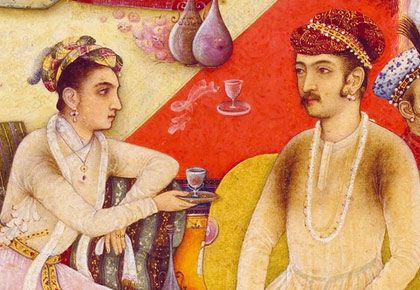 Excerpted from The Mughal Feast: Recipes From The Kitchen Of Emperor Shah Jahan by Salma Husain, with the kind permission of the publishers, Roli Books.
Excerpted from The Mughal Feast: Recipes From The Kitchen Of Emperor Shah Jahan by Salma Husain, with the kind permission of the publishers, Roli Books.
TELL US: Which is your favourite Mughal food? Share your comments in the messageboard below.


